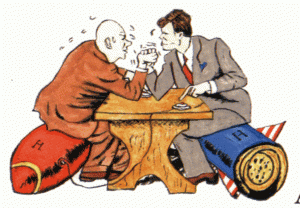
America in the 1950s saw the rise of popular culture, consumer goods and the suburban home. In 1945, British Prime Minister Winston Churchill had declared that America “stands at the summit of the world”. Indeed, to the outside world she was the image of prosperity.
Yet in reality America was gripped by something far greater: fear.
Since 1947, Cold War fear had spread like a fever throughout the country. From Hollywood to the suburban home, fear of Communist infiltration, stories of nuclear winters and warnings of imminent Soviet attacks made their way into every aspect of American life.
The Emergence of Sci-Fi
Ever wondered where science fiction stories come from? Unsurprisingly, stories of aliens using mind control, mutant sea creature attacks and mad scientists became all the rage in the 1950s.
In a country where radiation poisoning, nuclear winters, and Russian villains were very real fears, it’s not surprising that these anxieties found a voice in movies about mutant ants and space travel. Blockbuster hits such as The Incredible Shrinking Man (1957), Invasion of the Body Snatchers (1951), and The Thing From Another World (1951) took America by storm.
The Hollywood Blacklist
The US government’s domestic policy during the 50s was largely shaped by anti-communism – a fear that also made its way to Hollywood. Between 1945 and 1952, Congress held 84 hearings designed to put an end to “un-American activities”. The hearings were run by the House of Un-American Activities Committee (HUAC), who quickly settled the gaze on the Hollywood film industry, which was seen as a hotbed of communist activity.
Hundreds of Hollywood entertainers suspected of Communist affiliations were called to testify before the HUAC, leading to the blacklisting of hundreds of suspected activists and sympathisers. The Hollywood Blacklist came to an end in 1960, but by that time thousands had lost their jobs, dozens were jailed and many more sought political freedom in other countries – so much for “the Land of the Free”.
Family Life
The clash between the 1950s image of American domesticity and the terrifying prospect of nuclear war is best symbolised in the educational propaganda produced by the American government. In pamphlets such as ‘Grandma’s Pantry’, smiling housewives are encouraged to stock up their pantry so that their families can still eat nutritious meals, nuclear fallout or no nuclear fallout. In the classroom too, a friendly cartoon turtle called Burt encouraged children to ‘duck and cover’ in the event of a nuclear attack.
Look beyond the white picket fence and you’ll see that 1950s America was not the decade of prosperity, consumerism and confidence that we’ve all come to imagine. Paranoia gripped the country as the menace of Communism edged ever nearer, threatening to destroy the American way of life. Yet from this fear grew enduring aspects of popular culture; science-fiction films, spy novels, and even the bikini (named after the atomic bomb dropped over Bikini Island), all have their roots in Cold War fever.
